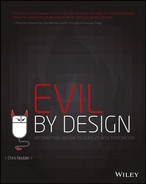Greed
The point is, you can't be too greedy.
Donald Trump
Greed is the desire to get or keep more stuff than you need, either accumulating money or possessions (“whoever has the most toys wins”) or just to feel better than someone else does.
Because greed prevents other people from having access to a thing that they could use more than the greedy individual could, it’s seen as selfish or spiteful. The reason it’s seen as one of the seven deadly sins is that greedy people obviously distrust that God will provide all they need.
All talk of sin aside, there does seem to be a correlation between having more than one needs and being selfish. When talking about haves and have-nots, there are four possible behaviors: selfishness, altruism, spite, and cooperation.
Greed happens when people pursue their own agenda at the expense of others, leading to selfish or spiteful behavior. Paul Piff, a social psychologist at UC Berkeley, found that people who “had more” (those in higher social classes) were less ethical, and more likely to lie, cheat, or steal. Interestingly, it wasn’t that more greedy people made it to a higher social class, but that getting to a higher social class reinforced those behaviors, making people more likely to be greedy. As Piff puts it, “Upper-class individuals’ unethical tendencies are accounted for, in part, by their more favorable attitudes toward greed.”
The reverse is also true. In another set of studies, Piff found that people in lower social classes are more generous, charitable, trusting, and helpful even at cost to themselves. This helpful have-not behavior is classic altruism. Others in Piff’s team ran a study that found lower-class individuals were more compassionate and less selfish.
The four possible behaviors between two people who want access to the same resources

It seems that the more you have, the less you need to rely on others. The less you need to rely on others, the less you care about them. The more you have, the more likely it is that you are surrounded by others who also have more, and so the less likely it is that you will need help. Greed therefore feeds upon itself, helping people to justify their increasingly selfish and spiteful behaviors.
So how does greed happen? How does it get reinforced? What triggers cause people to be greedy, and how do companies benefit from this behavior?
Learning from casinos: Luck, probability, and partial reinforcement schedules
Imagine that you are a game show contestant about to make a play for the grand prize. You are shown three doors. The host tells you that a new car waits behind one door, and the other two doors hide goats. The host asks you to choose a door. After you choose it, the host opens one of the two doors that you didn’t choose, revealing a goat. Now, to add an element of excitement, the host gives you the option to switch your choice to the other unopened door. Assuming you’re more interested in winning a car than a goat, what do you do?
After the game show host opens the door, most people expect that there’s a 50-50 chance that they have already chosen the correct door. Because they have already made their choice, they are attached to their current door (the endowment effect) and so they stick with it.
However, the correct answer is to always switch because there is actually a two-in-three probability that the car is behind the other door.
Think of it this way: Before you made a choice, there was an equal one-in-three probability that the car was behind any door. That means there was always a two-in-three probability that the car was behind one of the two doors that you didn’t choose. That fact doesn’t change after you make your choice, and it doesn’t even change when the host opens one of the doors you didn’t choose. Even though you now know which door is not hiding the car, the other unchosen door retains its two-in-three probability because you could still theoretically choose the door that has already been opened.
Say you first choose the left door. The probability of the car being behind one of the other doors is 2/3. It stays at 2/3 even after the host opens the right door. By switching, you keep the 2/3 probability with the added benefit of having one of the options eliminated.
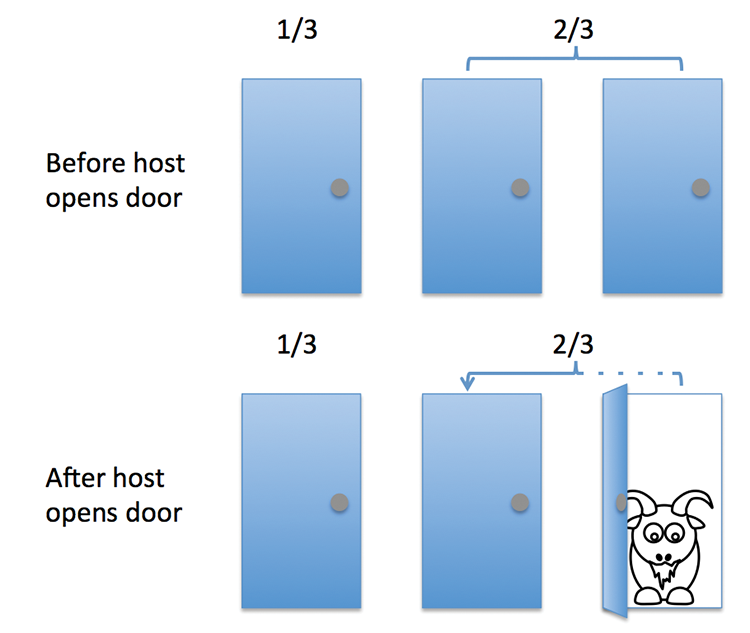
If that explanation made your brain hurt, welcome to the world that most people inhabit. The previous example is called the Monty Hall problem after the host who popularized it on the Let’s Make a Deal game show, and yes, they really did use goats. It is a great demonstration of the difference between mathematical probability and common sense. And yet strangely, despite the confusion that most people feel when dealing with questions of probability, they feel qualified to play the odds every time they enter a casino or buy a lottery ticket.
In North America, lotteries created $66 billion in sales, resulting in a $20 billion profit in 2010. Forty-three states, DC, and Puerto Rico run lotteries, as does every Canadian province. Sixty percent of adults in states with lotteries report playing at least once per year.
Between them, casinos and lotteries account for 72 percent of all gambling in the United States. Americans spend more than $1 billion/day on slot machines in the 38 states where they’re legal.
On one level the people walking in to the casino to play the machines must know that their odds are low and that the house always wins. On another level, however, they are willing participants in the systematic removal of their money because they cling to a vague hope that they might just “win big.” Lotteries have the worst odds of all forms of gambling, but also the highest potential payout proportionate to investment. As the Kentucky state lottery slogan points out, “Somebody’s gotta win, might as well be you.”
The casinos’ and lottery providers’ job is just to reinforce this belief. How do they do this? As just pointed out, a large part of the problem is the players’ inability to properly measure risk.
We aren’t good at understanding randomness either. Consider the outcry when on July 11th 2007, the five numbers picked for North Carolina’s Cash-5 lottery were identical to the numbers picked on July 9th. There were cries of tampering and calls for investigations. The state lottery director even had to be dragged out to explain that different machines and different balls had been used on the two occasions, so it was impossible that tampering had caused the repeat. The thing is, although it looks strange, there’s no reason for the numbers not to repeat. That’s the nature of randomness. The same numbers are just as likely to come up again as are different ones. The probability of it happening in any given 3-day period is only 1 in 191,919.
And it has happened at least a couple of times subsequently. In September 2009, a Bulgarian lottery drew the same six numbers two times in the same week. In 2010, the Israel National Lottery produced the same numbers, pulled out in the exact reverse order, just seven draws apart.
Because it is hard to measure risk, and because we like to think we see patterns where there is only randomness, we’re susceptible to the gambler’s fallacy. That is, we believe that a win becomes more likely after a series of losses. And despite the cognitive dissonance you’d think it causes, we also believe that there is a “winning streak” effect, where after we’ve won once, we’re more likely to continue winning.
And that’s where the casinos draw us in. It’s okay to lose most of the time, just so long as we win occasionally, or at least are surrounded by people who appear to be winning.
The appearance of winning—or nearly winning—is what makes casinos so appealing to many. (mandalaybay.com, excalibur.com, bellagio.com, luxor.com)

This occasional winning in among multiple losses is called a partial reinforcement schedule. To understand reinforcement schedules we should begin with Ivan Pavlov and his dogs. Pavlov was collecting dogs’ saliva to study their gastric function. He noticed that his dogs would start drooling more when they heard the sounds associated with food preparation. He experimented further, pairing the concept of food with the sound of a bell. When he subsequently rang the bell, the dogs would drool even though no food was present.
This was a continuous reinforcement schedule—every stimulus was associated with a reward. The dogs would stop responding (drooling) quickly if no food appeared after the bell was rung.
Later, B. F. Skinner was performing learning experiments with rats and pigeons when he found that sometimes withholding the reward for a correct behavior led to the animals continuing to exhibit the behavior for longer.
This became known as a partial reinforcement schedule. Unlike Pavlov’s dogs, who quickly stopped responding to the bell if no food was given to them, Skinner’s rats and pigeons would continue at the task for much longer if they were only rewarded (reinforced) occasionally rather than every time. For this reason, a partial reinforcement schedule is much harder to break than a continuous reinforcement schedule.
And what type of schedule do the casinos and lottery providers use? A partial reinforcement schedule. Humans respond in similar ways to rats and pigeons when given an occasional reward for repetitive behavior.
Casinos are a visual indication of the ways that companies can benefit from greed through creating aspirational, conditioned behavior and emphasizing the “luck” of winning. This section talks about several of the other ways that this is exploited.
The principles used when training animals are not that different to those used when designing successful computer games. During an initial learning period, there must be a sufficient reward for the participant (animal or player) to continue exhibiting the correct behavior. Over time though, the rewards can be given further apart or only for certain combinations of behaviors.
When the rewards are backed off, they can either be given once every certain number of times the behavior is shown (a fixed ratio schedule), or on average once within a certain number of times the behavior is shown (a variable ratio schedule). Rewarding in a specific timeframe, again either fixed interval or variable interval, can do the same; although, this does not provide such a strong reinforcement.
In dog training, you start by rewarding everything that looks like the behavior you want with a treat. Subsequently, you reward only the exact behavior you want. When the behavior is set, you can move to a partial reinforcement schedule where the dog is only given a treat occasionally. The dog will continue to perform the exact behavior even though it is not rewarded every time.

Computer games are designed to keep us playing. Reinforcement might come in the form of points, leveling up, or getting better equipment or in-game skills. As John Hopson puts it in an article for Gamasutra, that reinforcement isn’t random. It happens in response to actions the player performs. Early in the game, it might happen frequently to reward players for mastering a certain type of move or just to keep them interested as they learn the game mechanics. Later in the game, the frequency of reward may drop off. The more invested the player, the less reinforcement they need. Actually, sometimes just reaching the next piece of the puzzle after struggling through a particular stage can be a sufficient reward. What has happened is that the motivation to continue has moved from being extrinsic,based on the rewards being given by the game, to being intrinsic, based on the personal challenges of mastering the game.
A fixed ratio or fixed interval schedule leads to times when the reward seems a long way off—such as just after leveling up, when it takes a lot more points before the next opportunity. To keep people playing during this time, it makes sense to use a variable ratio schedule for some other activity in the game, such as killing enemies, so that they feel there’s always a chance of being rewarded for some minor goal they’re working toward rather than being disheartened by the far-off major goal.
Another approach for game designers is to produce events that are negatively reinforcing. In other words, players work to prevent them from happening. An example might be going too long without logging in to Farmville, only to find spoiled crops and rampant animals. To prevent this, players must remember to tend to their farms frequently. Negative reinforcement rewards people by taking away a bad outcome. You reinforce the behavior by associating it with bad things not happening. This is very different from punishment, where you try and stop a behavior by associating it with bad things happening.
And as it is in games, so it is on the Internet. Facebook users checking to see how many Likes they received for a post and Twitter users counting followers are working on a variable ratio partial reinforcement schedule. People hunting for bargains in Amazon.com’s Gold Box are working on a fixed interval partial reinforcement schedule.
That leads to a simple way to break online habits. Often it’s enough just to visualize ourselves as a pigeon in a box, pecking in response to the rewards being fed to us by the online sites, for us to realize that we’re being rewarded for actions that potentially benefit the site more than they benefit us.
- Keep people engaged by creating multiple goals that can be worked on simultaneously.
- Some should be longer-term fixed interval/ratio events, which happen after a certain time has elapsed or a number of items have been collected.
- Others should be shorter-term variable interval/ratio events, which happen within a certain time range or after a number of enemies have been killed, but with an element of uncertainty built in, so it’s not always clear exactly when the reward will be given.
- Prevent people from ignoring you by using negative reinforcement. Design the interaction so that bad things happen if the user doesn’t visit regularly. Using a variable interval before the bad things occur will mean they don’t know exactly when to return, increasing anxiety and the likelihood of checking in.
How do you convince people to take the stairs rather than an escalator? Or recycle bottles? Or obey the speed limit? In 2009, Volkswagen ran a competition to find the best ideas for changing people’s behavior for the better. One entry showed how installing touch-sensitive strips arranged like piano keys on the staircase exit from a train station in Odenplan, Stockholm led 66 percent more people to choose the stairs than the escalator, simply so they could “play” the piano as they walked. Adding a choose-the-right-hole game to a bottle recycling container (and displaying a high score) led to 100 versus 2 uses in one evening. The winning entry was a speed camera lottery that redistributes fines levied for disobeying the speed limit to the people who actually obeyed it. The pilot implementation resulted in a 22 percent reduction in speed from an average of 32km/h to 25km/h.
So it appears that when given the right reasons or rewards, people can be persuaded to perform real-world tasks they otherwise wouldn’t.
Considering how easy it is to capture, count, and reward behaviors electronically, it should come as no surprise that there are similar games in the online space.
Some are actual games, such as Fold.it and DigitalKoot. Fold.it uses a game-like reward system to help show that humans can be more effective than computers at folding proteins into correct structures. The protein folding work is important for discoveries in many fields including combatting AIDS and cancers, and the Fold.it team hopes that any advances in folding strategies that the players create can be fed back into computer algorithms, making those algorithms better at doing their job.
DigitalKoot was an effort run by the National Library of Finland to correct words that had been poorly digitized when the National Library moved its newspaper archive online. Players typed in words as they were presented onscreen by in-game mole characters, thus allowing the moles to build a bridge and cross the water. The game-like elements (tasks and scores) led to some individuals volunteering more than 100 hours of their time, with the top-ranked player completing almost 350,000 tasks over 395 hours. That’s the equivalent of 10 full-time work weeks spent identifying blurry Finnish words. All told, the game’s participants fixed more than 8 million words in under 2 years.
Other online game-like applications use crowdsourcing to complete trivial tasks. Google until recently ran the Image Labeler application, which pitted two players against each other producing descriptive words for a picture. If both chose the same word, they would be awarded points based on the specificity of the word, and thus its suitability as an image label. This obviously helped Google provide more appropriate images in its image search results, but the game approach, with a set time to complete the task, a variable score based on answer quality, and a high score table, made it fun for users, too.
Fold.it is an online game with real purpose. Players have been listed as authors of scientific papers for their contributions to preventing or treating diseases, despite having no formal scientific training (image courtesy of the fold.it site).
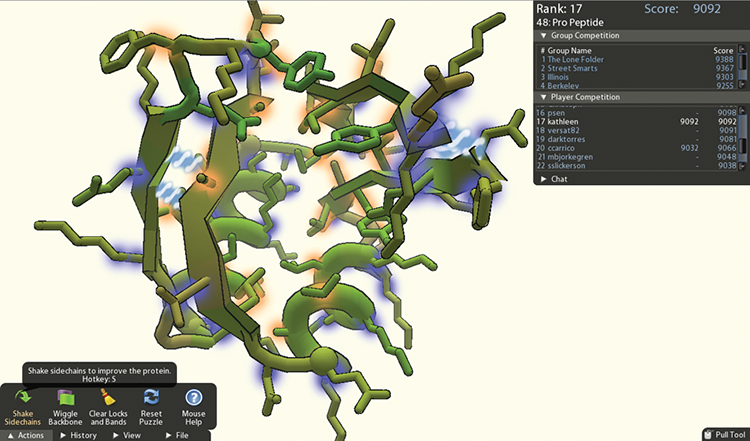
Waze is a GPS navigation app for mobile devices that integrates a social element into the route finding process. Users of the app (“Wazers”) can see each other on the map interface. Any user can report traffic jams, speed traps, and other slowdowns and can update map information such as points of interest, addresses, and road changes. Reporting changes gives Wazers points, which unlock different avatars and denote status in the Waze community. Just the act of running the application while driving provides real-time speed information to the Waze servers, which is then used to help other users choose the best route.
All these elements are designed in a way that makes them appear game-like, but Waze’s real innovation was in getting users to help create the base maps for the service. When the company starts in a new location, it relies on open source or commercial map information that might be out of date or inaccurate. After a Waze user has driven a route, Waze can be more confident that the roads are actually where the map said they were, so the company has found an interesting way to incent people to take a route they maybe wouldn’t have normally used. Roads that Waze needs more information about display with dots overlaid on them, much like the original Pac-Man game. To incent people to take those routes, items such as cupcakes appear in tempting locations. Driving the route “eats” the dots and cupcakes in real time and simultaneously increases the Wazer’s score. As a result the Wazer is happy because they get more points, and Waze is happy because it has more accurate map and route information.
None of the rewards mentioned in this section have any monetary value. Instead they have societal value—at least within the community of fellow game-players. That societal value is enough to keep people coming back and participating, earning points in exchange for their time and effort.
- Find a way to let two individuals compare their abilities at the task you want them to complete. After you have the comparison point, turn it into a scoring mechanism, and keep track of individuals’ scores. The very fact that there is a high-score table will encourage competition.
- Publicly broadcast the top scores so that players can claim bragging rights.
- Make the underlying reason for performing the task clear, especially if it is for a charitable cause or for the greater good. That gives people more reason to participate.
- Add an element of fun to the task process. For instance, DigitalKoot chose to use moles holding up placards with the scanned words on them. That created much more whimsy than merely showing the word on the screen. Waze has drivers chasing dots onscreen like a version of Pac-Man, with occasional cupcakes as a special reward.
What’s the difference between a lottery and an auction? When you look at the fMRI images of people winning either a lottery or an auction, the same reward centers light up. But, when people don’t win, things look quite different. The brain activity in these reward centers decreases much more when losing an auction than losing a lottery. Actually, the more the activity decreases, the higher the likelihood that someone will bid more for the auction item than it is actually worth.
Because of the comparable brain activity when participants won their auctions and lotteries and the differences in activity when they lost, the researchers put the overbidding behavior down to fear of losing rather than joy of winning.
In other words, when the activity has an element of skill or competition (auctions), people feel more of a sense of loss than if it were purely luck-based (lotteries and sweepstakes).
JCPenney (a U.S. department store) experimented with removing the word “sale” from its vocabulary and instead emphasized “month-long value.” Their reasoning was that consumers couldn’t be expected to keep track of the 590 unique annual sales events. Instead it grouped discounts into three categories: everyday low prices reduced the artificially high mark-up from some items; month long deals dropped prices on select items for a longer period of time; and best price was the new name for clearance sales.
The result of this strategy was that revenue dropped 20 percent at the same time that it was rising at rival Macy’s stores in the same malls. Apparently people like their sales. Why? Maybe because sales reward bargain hunters—the people who go specifically out of their way to find cheaper items rather than just stumbling upon them by chance. They like to feel they’ve won and that there was an element of skill, rather than feeling like they were lucky.
Paco Underhill, who researches consumer behavior in stores, suggests, “Sales are just like heroin.” Stores’ strategy of moving to every-day low prices when they used to offer specific sales events takes some of the fun away.
That might explain the success of eBay’s 2008 “Don’t just shop, win!” ad campaign and of sites such as Groupon, an online coupon site whose tag line is “Find great deals on fun things to do.”
Groupon has built its whole business around sharing deals with its subscribers. Every day, Groupon sends out an e-mail with local deals. Its offers are only available for a certain time period, and Groupon requires a certain number of participants to sign up to unlock the discount. In other words, if in-store sales are like heroin, Groupon is a bargain hunter’s crack cocaine.
Part of the draw of Groupon is discovering new deals, and to reach the requisite number of individuals to “unlock” the discount, it behooves bargain hunters to tell all their friends about the offers as well, doing Groupon’s advertising. All the elements of fear of losing are present. Limited time, exclusive offers, limited access to certain merchants, a minimum participation requirement, sometimes a quantity limit, and upfront payment to secure the discount. Although it doesn’t take much skill, there’s still a feeling of “winning” the deal.
Groupon relies on the thrill of the bargain hunt. Customers are highly motivated to tell their friends about offers because that helps ensure that the minimum number of people sign up to “unlock” the deal. Of course, Groupon makes sharing easy by integrating with Facebook and other social media platforms. (groupon.com)
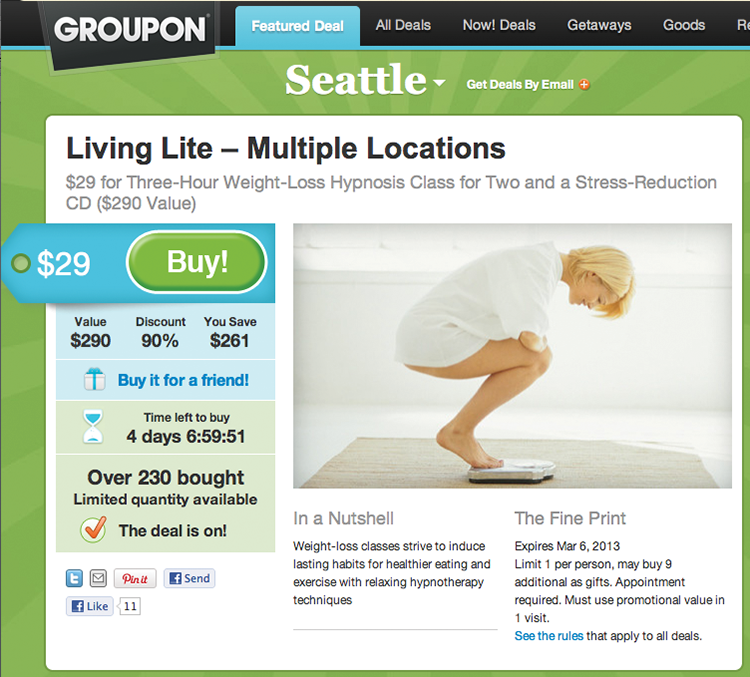
Groupon benefits on the seller side as well. Merchants typically offer a 50 percent price reduction on Groupons and then split the remaining revenue 50/50 with Groupon, in exchange for Groupon’s promotion and handling of payments. This means that merchants are offering services for one-quarter or less of the regular price. That might not seem like a great deal to merchants, but because Groupon only offers a limited number of deals per day in each market, and because there are enough merchants desperate to get involved, Groupon can play the exclusivity card and define the terms.
As Rocky Agrawal at TechCrunch points out, what Groupon offers to merchants is cash now in return for deeply discounted goods later. The most successful businesses might not need the cash infusion and wouldn’t choose to play on Groupon’s terms. The ones who are struggling and need some quick cash will be much more willing customers. That doesn’t actually bode too well for consumers.
Some merchants have been so swamped with bargain hunters (now known as the Groupon effect) that they have been unable to properly service the deals, and their overall customer service has suffered as a result. And the marketing benefits might not always be there. Fast Company reports survey results that show more than one-half of past deal-participating businesses don’t plan on doing another offer in the next 6 months.
It seems that people are only in it for the deals. Because they are motivated more by the thrill of the hunt and the fear of losing out than by the actual products they’re getting at a discount, deal seekers are unlikely to become long-term customers. So they’ll continue to visit Groupon for new deals but not form a sustainable relationship with Groupon’s merchant partners.
- Play upon the fear of losing out. Make people aware that their skill or perseverance determines their success.
- Introduce a (manageable) challenge that must be completed to obtain the “prize.”
- Even for plentiful items, make people “qualify” to purchase them.
- Manipulate availability variables such as time, quantity, or escalating cost to trigger fear of losing out.
As Bertrand Russell said, "One of the painful things about our time is that those who feel certainty are stupid, and those with any imagination and understanding are filled with doubt and indecision."
In 1999, David Dunning and Justin Kruger backed up Russell’s assertion with some seminal research in this field (which, incidentally, won them an Ig Nobel prize in Psychology), showing that indeed those individuals who performed worst on a series of skill tests thought they had performed much better than they actually had. Test participants who had performed well had a tendency to believe they had performed comparatively poorly. Even after showing test participants their own results, whereas the individuals who had scored well could correctly estimate their own ranking, those who scored in the 12th percentile (that’s quite bad) still placed themselves above average.
It was only after the low-performing participants were given some training in their lacking skills that they could better estimate their actual rank. Their estimating skills improved regardless of whether the training they received actually improved their performance. In other words, it was only when they became aware of what they didn’t know that those people could correctly identify themselves as poor performers.
So the poor performers needed to be given an understanding of what it took to have real skill before they could make a good estimate of their own skill level. The higher performers similarly didn’t understand that they really do have higher skill levels than other people—they believed that others were better than they actually were.
This behavior—unskilled individuals suffering from illusive superiority, whereas skilled individuals suffer from illusive inferiority—is now known as the Dunning-Kruger effect.
Dunning and Kruger’s studies used tests of logical reasoning, grammar, and humor, but the same effect holds across other domains, at least for a Western audience.
There are several online activities that are open to anyone to participate in, but which require some serious skills to actually succeed at. One of the most obvious areas is online financial trading. Although it’s probably true that you could observe the Dunning-Kruger effect in action with simple stock trading sites, the most fun occurs on sites that broker trades in the derivatives market: options and futures.
Options and futures are two financial instruments that—on a basic level—enable speculators to place bets based on their expectations of how a commodity will perform in the future. In other words, they are showing their expectation of how the derivative of the commodity will perform. Of course, the term “bet” is not used because that would suggest that participating in this market is akin to gambling. Institutional players prefer the terms “hedging” and “speculating.”
And now it gets interesting. Along with trading in derivatives of regular commodities (precious metals, wheat, pork bellies, and such), you can also trade in things such as future housing prices, gasoline prices, or even in nontangibles such as weather derivatives to hedge against bad ticket sales if an open-air concert takes place on a rainy day.
Although the primary reason for trading in derivatives used to be to hedge other investments (the rainy day example for instance, or airlines hedging on future fuel prices), the high potential returns of 60 percent or more also encourage speculative trading in futures in their own right.
Just to warn you; if you’re thinking at this point that you’d like to participate in this type of market, unless you have degree-level understanding of advanced financial instruments, you’re probably in Dunning and Kruger’s “illusive superiority” group. But as a member of that group you won’t believe that you’re a member of that group, and plenty of websites exist to indulge your desires.
Many of these sites, such as TradeRush.com and 24option.com are housed in countries outside the direct regulatory control of the United States, but the North American Derivatives Exchange (nadex.com) is Chicago-based and has Commodity Future Trading Commission oversight. These aren’t fly-by-night concerns. Remember however that the site’s legitimacy doesn’t ensure your success as an investor.
24option’s site offers several reassurances that trading derivatives is easy. It offers tutorials, a sandboxed practice area, and low-cost trades. It’s easy to see how newcomers could get a sense of illusive superiority. (24option.com)

Most of these sites include a sandboxed practice area and tutorials that describe a simple set of rules for success. The tutorial rules tend to emphasize what happens when your option expires “in the money” but not what happens if it doesn’t.
For instance, on its overview page, 24option.com describes a three-step process:
However they conveniently left out the most important part of step 3: “…and, if you’re wrong, you just lost $500!” They also failed to mention that, either way, 24option will be making money through their commission.
The setup of the site, instructional material, and trading interface is such that novice traders are likely to feel overconfident. Because options trading can occur in short time frames (puts and calls can be for time periods as short as 1 minute), people can lose money quickly.
Even with indicators that things aren’t going as well as they should, people might be tempted to stick with the program because often the training information suggests that it takes time to develop a winning strategy. Dunning and Kruger caution that “poor performers do not learn from feedback suggesting a need to improve”—just the sort of people who’ll plow money into a financial vehicle they stand little chance of understanding.
Derivatives trading without serious experience and industry knowledge is likely to lead to an illusion of control. Even with that experience you can still seriously lose your way. Just ask Nick Leeson, who single-handedly brought Barings Bank to bankruptcy in 1995 by losing $1.2 billion through trading equity derivatives.
You can get some quick wins, and the low minimum investment makes it easy to gloss over early losses. The interfaces used by the web-based exchanges make the experience feel much like a game of chance with some added pseudo-skill built in. There are pretty graphs and glossy buttons with an invitation to enter a call if the derivative looks like it’s going up, or a put if it’s going down. Unfortunately, if it were that simple, there would be no spread and therefore no money to be made.
Warren Buffet calls derivatives “financial weapons of mass destruction.” After the large part that derivatives played in the global financial melt-down of 2008, who do you prefer to believe: the people who get rich from you playing the options game or the man who remains rich from not playing it?
- Give people a set of relatively simple-looking rules to follow and a sandboxed area to practice in. This way, they’ll soon feel like they understand the principles of the task they are performing and feel qualified to play with the “big boys.”
- Provide social proof that it’s possible to win by encouraging customers to boast about their successes on a message board or other special area of the site.
- Keep ignorant people ignorant. In other words, don’t make people aware of what they don’t know. That way they will continue to overestimate their competence.
- Reward people early with “quick wins” so that they feel they’re getting the hang of the task.
- Make it possible to play with small levels of investment so that initial losses don’t feel too discouraging.
- Convince people that it may take time before they truly feel like they understand the process, but that they are doing great anyway.
Let’s go back to Pavlov’s dogs and Skinner’s pigeons. There was a difference in how Pavlov and Skinner introduced new behaviors in their animals, and that difference is important because it has implications for how long the behaviors last.
Pavlov made use of a built-in reflexive behavior (drooling) to form an association with a preceding condition (a bell ringing). In contrast, Skinner was performing operant conditioning. If the bird did the right thing, it received a reward as a consequence.
What does that mean for us? Well, Skinner’s conditioning was active, whereas Pavlov’s was passive. The dog wasn’t in control of its behavior in the same way as the pigeon was. The dog didn’t have to do anything conscious to get the reward, whereas the pigeon did. Making the animal take an explicit action produced a stronger, longer lasting effect.
Skinner also showed that making rewards happen on a purely random “luck”-based schedule leads to weird, superstitious behaviors. He found that if he rewarded pigeons on a random schedule, regardless of what they were doing at the time, it would condition them to start performing some seemingly strange actions. For instance, one pigeon would perform a dance, whereas another might bow or turn its neck in a certain direction. This happened because the pigeon would try repeating whatever action it was performing when it received the reward. Thus it was more likely it would be doing this same thing when the next reward arrived, and so on, until the random behavior had become superstitiously associated with the reward.
This may seem at odds with the appeal of gambling. After all, gambling is addictive at least in part because of its randomness. However, what makes gambling enjoyable is the addition of a gaming element to make people think they are offsetting the randomness.
In other words, giving people pseudo-control in where they place their chips, or how they play their cards gives them a level of perceived mastery over the randomness. At its most basic, this is the difference between pushing a button to see if you’ve won and choosing the correct one of two buttons to win. Giving people choices, and making them take an action, gives them pseudo-control.
There is also a higher perceived value in getting rewarded for something you did, over something that happened to you. The emotional component of investing time or skill to obtain the coupon makes it appear more valuable. You feel like you “deserve” your reward. As a result, people are more likely to value a coupon or discount when claiming that discount requires some skill-based activity than if they had just been given something that anyone could receive.
Some of the simplest online examples of this are giving discounts to people who have signed up to receive e-mail newsletters, or to frequent purchasers via reward point programs. These individuals took an action, and now they are being rewarded for it. Others who didn’t take that action are missing out. Of course, it doesn’t hurt that the actions people undertake to get the reward also help the retailer.
Some companies have built skill-based rewards in to their core functionality. Groupon is a coupon based discount site, but the skill element manifests through being on the site at the right time and with sufficient other people to trigger the discount. Foursquare users must attend a location to check in, and frequent attendance is rewarded with both in-app status (badges and mayorship) and real-world perks such as discounts.
Some companies have built their entire business around skill-based rewards. SCVNGR.com gets participants to do challenges at places to unlock rewards. The challenges mainly revolve around broadcasting something positive about the location on social media, or about performing actions that make it more likely that players will return in the future. Each action also gives a certain number of rewards, which can then be redeemed for discounts or free items at the participating locations.
Shopkick.com encourages shoppers to browse online and then earn points when they subsequently buy the items they browsed in a physical store. Shoppers earn a combination of location-based points (walk-in “kicks”), plus purchase-based points and rewards on linked credit cards. By getting participants to state a goal upfront, Shopkick encourages future actions by showing progress toward their wanted reward.
In all these examples there is a level of customer involvement—either action or risk—that gives the appearance of skill. The result is that recipients of the reward value it more than they otherwise would.
Obviously, the more value the user perceives in the reward above and beyond its face value, the more value there is to the business. A hard-won $1 discount may be worth disproportionately more in terms of loyalty than handing out $5 vouchers to everyone who enters the store.
SCVNGR uses a location-aware app to tell players what challenges are available in the vicinity. Performing challenges earns rewards in the form of coupons or free products. Having performed a task makes the reward seem more worthwhile. (scvngr.com)
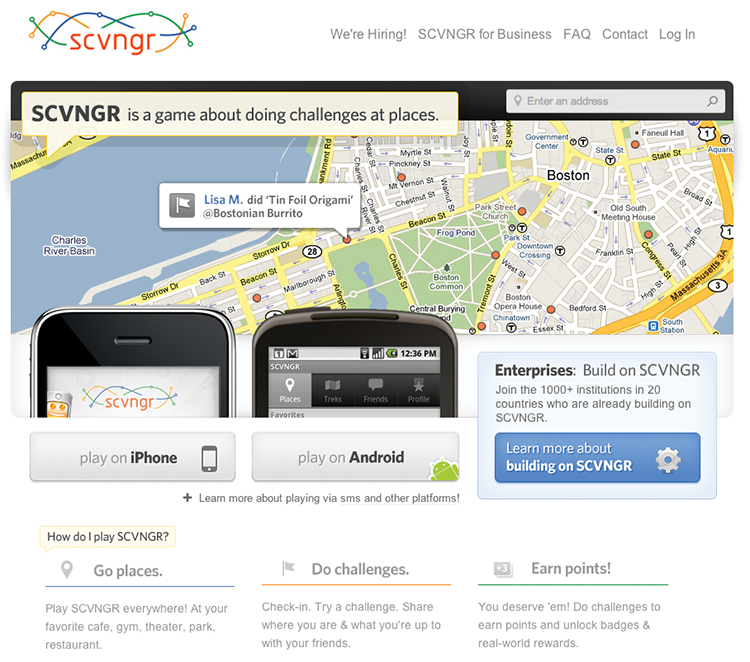
The best perceived value thus occurs when the barrier to winning requires just less than the amount of effort or risk that would make a customer decide not to act (play the game). Interestingly, it’s also likely to be the most ardent (hopefully, this equates to most valuable too) customers who are prepared to jump through the most hoops.
- Make customers perceive that they have worked for their discount, but keep the effort at a suitably low level that it doesn’t become a barrier.
- The “work” that customers do could involve a game of skill or a simple challenge such as being present at a certain time or displaying a specific item.
- Challenges and games should be biased to reward your target group. For instance, frequent customers should be challenged to take a picture of a past purchase whereas new members should be challenged to visit at least two store locations in a week.
- It’s okay to include a random element in the reward, but the randomness should appear to be controllable (that is, everyone wins, but the size of the reward is random within a set of parameters).
- Make it clear that the reward is only available to people who have completed the action, maintaining its exclusivity.
- Rewards need not be large—no more than the discount that a good customer might get anyway.
Back in the days of dial-up internet access, America Online (AOL) was synonymous with “The Internet” for many people. Subscribers found themselves within the walled garden of AOL’s content. Ostensibly the idea of these walls was to keep non-subscribers out, but actually the true value was in keeping subscribers in. That way they could be shown more of AOL’s advertisements rather than viewing content (and advertisements) on other sites.
It wasn’t just AOL doing this. Individual sites would have interstitial pages asking users whether they were sure they wanted to leave the site. Landing pages would have HTTP redirects so that if a user hit the browser’s back button, they’d be popped straight back into the site again.
Some sites still use these redirect tricks but users have grown less tolerant of them. Now, sites have realized the same thing as the TV companies. You need to have just enough content to keep users engaged so they’ll put up with the adverts you throw at them. For TV, that amounts to about 42 minutes of programming in every hour, the remaining 18 minutes being advertisements. Prime spots can have even more minutes of advertising, as can exclusive broadcasts.
In the future, we won’t need ad breaks because the advertisements will be there all the time, walling in our content [Idiocracy (2006), 20th Century Fox, directed by Mike Judge].
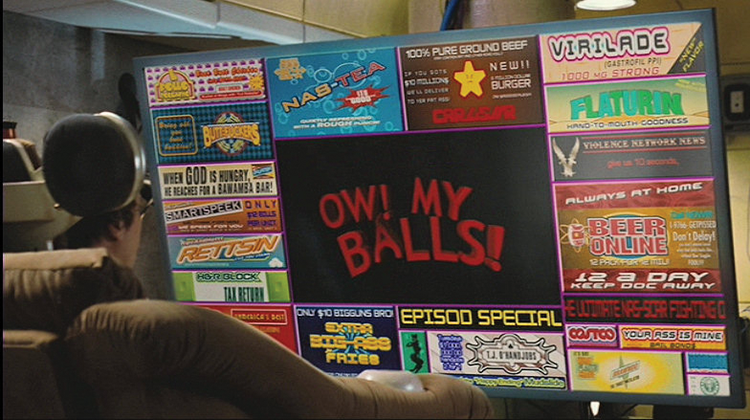
So is there still space for walled gardens online? Apparently so. Facebook has done this well and continues to offer users even more reasons to perform most of their actions within the confines of Facebook’s properties. Twitter does something similar. YouTube has become synonymous with video, but since 2008 it has also been the second most used search engine in the USA, second only to its parent Google.
The same thing can be true anywhere where people need to use the provided infrastructure rather than an open alternative – either because that’s where all their friends are, because that’s where all the tools are, or because that’s where they are guided when they start on their journey (like the original dial-up AOL).
There is however a difference between walled gardens and paywalls. Subscription sites such as the New York Times or Wall Street Journal have erected a wall to keep undesirable people out. That is very different from a wall designed to keep desirable people in.
Just ensure that the garden walls are elastic rather than rigid; clever companies let people out, but make it clear there’s more fun stuff waiting for them back in the garden. Facebook, Twitter, and Google achieve this by extending their presence outside their own walls, with “Like,” “+1,” and “Tweet” buttons on other sites, and with the option to use Facebook, Google or Twitter credentials to log in to other sites. Providing these features as a convenience to users also allows each company to track individuals as they venture beyond its walls, and then target behavioral ads based on their actions once they return to the walled garden.
- Own the infrastructure. AOL used to own the dial-up infrastructure for getting online, so users were directed to their content. Facebook owns the software infrastructure for posts, likes and walls in locations where everyone’s friends hang out, so users are tied to their environment.
- Carefully test your users’ advertising tolerance. The purpose of the walled garden is to maximize ad revenue (you own all the ad locations inside the garden), but if advertising is too intrusive users will leave.
- Let people leave the garden, but provide features that let you track them while they are out so that you can give them more targeted advertisements when they return.
- Constantly test your garden for completeness, and, when it fails to cater to your user’s wants and needs, grow it to once again so that users see no need to leave. (For instance, Facebook’s acquisition of Instagram to add photo-editing features.)
Anchoring and arbitrary coherence
The gas tank needle is on empty, but we drive right past a couple of gas stations simply because their prices are more expensive than what we paid the last time we filled up. It’s only when the car is running on fumes that we realize maybe we will have to fork over more cash than we want to.
What has happened? We formed an opinion on the price of gasoline (an anchor) when we last filled up. Now we compare the new prices that we see against this anchor. We are looking for coherence between the new price and the last price we paid. With a product that varies in price over time and over location, it’s hardly surprising to see price hikes but still we rely on our internal anchor until the evidence of several gas stations tells us that it’s time to perform a reset.
How much you last paid for gas creates an anchor for how much you expect to pay next time.
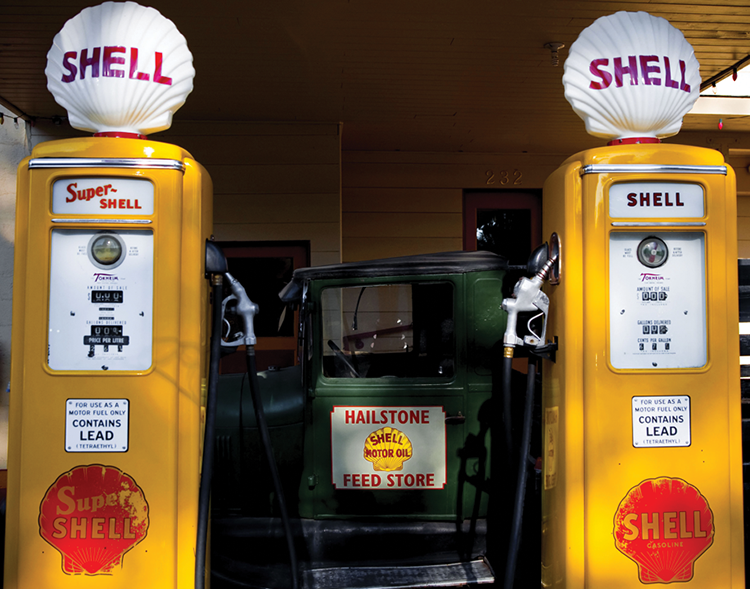
Still, when we perform this reset we don’t have a “gold standard” of gas prices that we are calibrating against. It’s unlikely that we even refer to government statistics describing current national average prices. The new anchor price that we create is instead somewhat arbitrary—it’s based just on our recent experiences. Thus, when we next need to fill up the car with gas, we’ll be applying our new arbitrary anchor because we seek arbitrary coherence, as behavioral economist Dan Ariely puts it.
To illustrate just how arbitrary this coherence-seeking can be, consider the prices of gasoline in the United States in recent history. In February 1999, the average cost of a gallon of regular unleaded gasoline was 91 cents. If at this time you saw a gas station selling even premium unleaded for $3/gallon, you’d just laugh, shake your head and drive on by. However, by July 2008, gas was at $4.11, a record 20-year high. If you saw a station selling it for $3/gallon, you’d join the line that wound around the block.
Now say that during this time you took a trip to England. You’d see prices of more than $6.75 per United States gallon. Setting this new anchor point means that when you returned home after your holiday, filling up would suddenly appear to be a bargain.
So our seemingly rational coherent view is anchored in both time and space. There’s little that we can do about it without finding a friendly Time Lord with a spare TARDIS, but then we wouldn’t need the gasoline anyway. It shows that the view we form on what is cheap and what is expensive is somewhat arbitrary.
How do designers of software and websites use this anchoring and arbitrary coherence seeking? An understanding of anchoring enables us to more easily reset people’s expectations, and by studying coherence we can find ways to either increase or decrease the set of items that people seek to compare.
Resetting people’s expectations can make them greedier. This is basically what happened to the people in Paul Piff’s studies mentioned at the beginning of this chapter. As they became richer and surrounded by other richer people, they changed their expectations of what behaviors were acceptable. Changing the set of items that people compare has a similar effect. By excluding items that provide a more considered baseline, companies can encourage consumers to justify their greedy impulses.
Say you’re looking to buy a new toaster. You haven’t started your research yet, but you have a vague idea of the price range you would expect to pay. Imagine that in the store, the first thing the sales assistant does is gets you to write down the last two digits of your Social Security number, and then asks whether you’d be willing to pay that price for the toaster. Next, regardless of your answer, the sales assistant asks what is the maximum price you’d be prepared to pay.
Now, the last two digits of a Social Security number (SSN) range from 00 to 99 and might as well be randomly distributed. What possible effect could this number have on toaster purchases? Interestingly, when used this way as an anchor number, the answer is “quite a bit.”
Itamar Simonson and Aimee Drolet at Stanford University found that even an anchor point as arbitrary as an SSN can influence how much people are subsequently prepared to pay for an item. Study participants whose last two SSN digits were in the 00–49 range subsequently proposed lower maximum purchase prices than participants whose last two SSN digits were in the 50–99 range. It seems that this totally unrelated number, when put in the correct context, was enough to create an anchor point even if the person with high SSN digits said they wouldn’t pay that price for the item.
Considering how easy it is to use even arbitrary numbers as an anchoring point, it should come as no surprise that companies use more realistic anchors as a regular sales technique.
Anchoring in a retail environment normally works by displaying a range of products, each with a similar aura of quality, but with progressively more features and progressively higher prices. The cheapest item now becomes the anchor point. It is this one that is advertised in sales fliers. The most expensive item becomes the high-end anchor point against which all others are compared. It is relatively simple for sales staff to move a customer up through the range of items by showing the comparative benefits of each subsequently higher priced option, all of which still seem cheap in comparison to the high-end anchor point.
An alternative approach is to set a fancifully overpriced high-end anchor so that all other prices seem reasonable in comparison. Restaurant menus do this, showing the expensive cuts of steak and seafood dishes at the top of the menu, and cheaper pasta dishes further down. Even if the pasta is expensive, it’ll seem cheap in comparison to the steak.
In a retail environment, this is nowhere more apparent than with high-end audio equipment, where spending $500 per speaker seems positively reasonable in comparison to the $25,000 alternatives on offer.
Bowers and Wilkins products at Magnolia HiFi. Seeing the Zeppelin iPod dock in comparison to the high-end speakers makes it seem cheap. What’s not clear here is that it’s still ten times more expensive than other available iPod docks. (magnoliaav.com)

A more common situation is purchasing accessories to go with a new product. Stores often offer a discount on accessories bought in the same transaction as the product, and for good reason. The product provides the anchor point, so any accessory looks cheap in comparison. Coming back the next day to purchase accessories, we’d be comparing them against each other rather than against the price of the original product.
You can even reset an anchor point on multiple occasions if you are selling something that people don’t buy frequently, or don’t research as much as they should. In 2010, Best Buy started raising the price of one computer every week, and then advertised that computer in their paper flyers with the price highlighted. They never used the word “Sale,” just the term “New Price.” Thus, they managed to set a new anchor point for many customers that was actually higher than the previous product price.
- For a high-end anchor:
- Show a range of comparable products, with the most expensive setting a high-end anchor price sufficiently large to make the rest of your products look cheap by comparison.
- Make frequent comparison to the high-end anchor when describing other products’ prices.
- For a low-end anchor:
- Show a range of comparable products, with the cheapest setting the lowest price that you are comfortable with.
- Ensure that the low-end anchor price does not deviate substantially from customers’ expectations, or that comparison with other vendors is difficult.
- Start from the anchor point and then work customers upward toward more expensive products in the range.
Capcom made the news in late 2011 after a child racked up $1,400 in in-application purchases of the Smurfs iPad game. The 8 year old, Madison Kay, had purchased Smurfberries and other items in the game, which were then charged to her mother’s (the iPad owner’s) iTunes account.
As a result of this and other similar news items, Arkansas Senator Mark Pryor wrote to the FTC saying "children, in particular, appear to be confused by in-app purchases, leaving parents with an unexpected bill for virtual smurfberries, snowflakes, or other products. In the end, it would appear that these app companies may be the ones having all the fun and games at our children's expense."
The FTC has so far investigated the app descriptions on the Apple and Google app stores and concluded that the stores “must do more to ensure that parents have access to clear, concise, and timely information about the apps they download for their children” but has not yet evaluated what protections should be put in place to prevent unauthorized in-app purchases. In March 2013, Apple proposed a class-action settlement that allows parents who did not authorize their children’s in-app purchases to claim refunds.
The way that the in-app purchases break coherence is by exchanging dollars for tokens. Individual games might use Smurfberries or snowflakes as their currency, but each of the major games companies also uses a token-based economy rather than stating costs in dollars. Partly this system enables children and others without credit cards to make online purchases when somebody with a credit card has populated the account with points, but it also has other benefits, mostly for the token issuers.
Using points allows companies like Nintendo to manage their online digital assets for the Wii and DSi gaming systems more easily because all prices are quoted in points, not local currency. It’s probably a good thing that points cards are not redeemable outside their country of purchase because otherwise with the current spread, Nintendo Points would be trading on foreign exchanges worldwide. Nintendo Points officially cost $1 per 100. However, in the UK the same 100 points cost £0.70, which is about $1.20 at the time of writing. In Europe, 100 points cost €1 ($1.30). Now Nintendo isn’t responsible for global currency fluctuations, but sometimes it appears to pay to be an American rather than a European gamer.
By converting currency to points, the real-world coherence is removed. The Smurf game is free to download from the iTunes store, but if you want to progress you’ll need lots of Smurfberries, which are conveniently available for in-game purchase. Players trading in Smurfberries are probably not considering the dollar equivalent of their purchases.
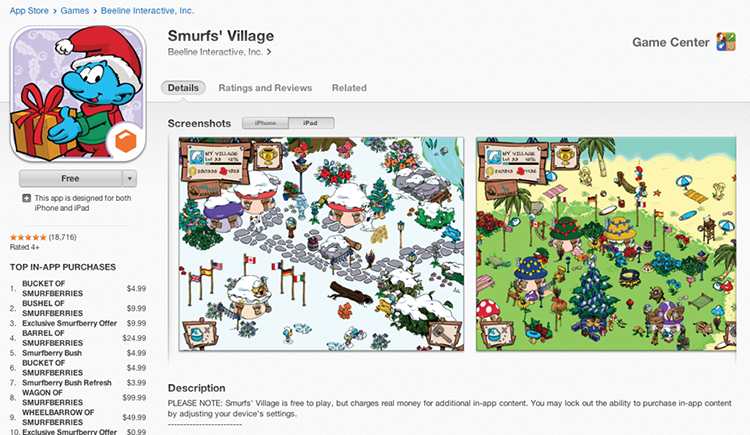
Microsoft Points mix things up a bit more—using these points to buy songs on the Zune music player (yes kids, it’s a bit like an iPod only not so hip) costs 79 Microsoft Points. That sounds cheaper than Apple’s 99 cents per song until you realize that a Microsoft Point costs more than 1 cent—you get 80 points to the (US) dollar. Microsoft also sells cards with different numbers of points in different countries. This way, the card can still hit a “magic” price point such as 19.99 or 39.99 when it is sold in each local currency.
So the link between dollars and points is quickly cut. This makes the cost of items within the company’s infrastructure much more arbitrary than it would have been if direct dollar comparison was possible.
In addition, with all these systems, consumers must prepay for content. To purchase a single song or game, they must first buy a points card with several thousand points (1,600 or 4,000 for Microsoft, 1,000, 2,000, or 5,000 for Nintendo). That leaves the points issuing company holding on to a large portion of the users’ cash until such time as they choose to redeem the points (if ever—see the “Encourage breakage” pattern).
- Decouple the token value from a specific dollar value. When prices are listed in token currency, people will forget that the magic 99-token price point actually cost them $1.20.
- Sell tokens in large blocks, corresponding to price points that consumers see as valuable (19.99, 39.99).
- Keep the process of replenishing tokens separate from the process of spending them so that people are less likely to consider the real price of tokens.
- This also allows separate people in a household to be responsible for replenishment than are responsible for spending, further removing any concept of the dollar value of tokens.
- Ensure that tokens can be used only within the jurisdiction where they are purchased to prevent speculative trading.
- Use tokens as rewards within the system. Offer a certain limited number of tokens when users achieve specific goals.
- Potentially only allow redemption of these earned tokens after customers have also purchased tokens outright.
Gift cards are a win-win proposition for retailers. Customers tend to either never redeem gift cards they have been given, redeem only part of the card, or spend an additional 15–40 percent in the process of redeeming the card.
Gift cards are popular presents, but redeeming them is fraught with difficulties that end up leaving the issuing companies as the winners. Amazon.com counters this fear by clearly stating that their cards have no fees and never expire.
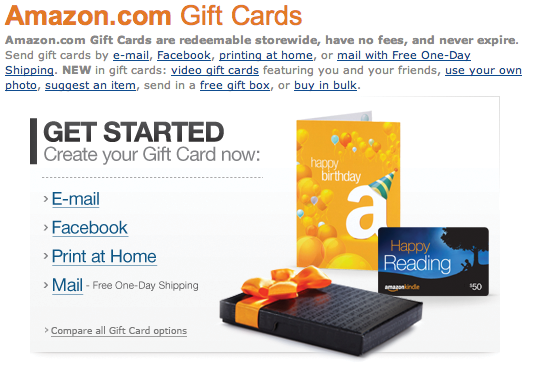
The industry term for the dollar value of unredeemed prepaid items is breakage. Breakage is big business for retailers who offer gift cards. In 2011, the electronics retailer BestBuy reported $53 million in income on the value of unredeemed gift cards. Estimates suggest that anywhere from 10 percent to 19 percent of card balances go unredeemed, for a total of approximately $41 billion dollars in the period from 2005 to 2011.
The currency doesn’t have to be dollars for this tactic to work. Any prepaid gift card, such as Microsoft Points or Facebook Credits, can suffer from breakage.
It’s also a common technique in other industries, such as cell phone service providers who “bundle” prepaid services that consumers don’t actually want or use, or who require prepayment for highly variable items such as data usage. In these circumstances the breakage is either the number of text messages or voice minutes that expire every month because you didn’t use them, or the megabytes of data that you didn’t consume. Yet if in one month you use more than your allowance, the penalties for “overages” can be extreme.
To maximize breakage, unscrupulous companies make it hard to redeem the full value of the prepaid item without either leaving money behind or contributing more money to complete the purchase. This can be done by coordinating gift card denominations to always be slightly less or slightly more than the cost of in-store items. For instance, a coffee chain may sell gift cards in increments of $5, knowing that the average drink purchase is $3. This either leaves $2 on the card, or requires the customer to spend an additional $1 (20 percent) to clear the card’s value.
Procrastinating about spending a gift card can also be a bad idea. Forcing an expiration date on cards to increase breakage was so lucrative for a time that in 2009 the U.S. Federal Government stepped in and pinned expiration dates at 5 years to prevent companies from “reclaiming” unused gift card value before that time had elapsed. That didn’t stop Amway from putting a “redeem before” date on their gift cards, claiming it wasn’t an expiration date, just a suggestion. Luckily for consumers, the courts disagreed with Amway’s interpretation. However, companies can still charge fees after a gift card has been inactive for more than 1 year. Those fees can, over time, completely remove the value of the card.
- Ensure the smallest denomination of points card is at least 10–15 times the cost of the cheapest available item.
- Make sure that points cards and refills are offered in denominations that leave remainders. For instance, if individual items cost 79 points, then a 1,000 point card will leave 52 points—insufficient to purchase a thirteenth item, thus requiring purchase of a new card or forfeiture of the remaining points.
- Make points expire after a set period, or start charging administration fees.
People typically buy more expensive products because they expect them to have higher quality and be more enjoyable than cheaper alternatives. For instance, when buying tools and other hardware products, the advice is often to buy the item that is one price point up from the tool that would actually get the job done. The implication is that the higher price point item will be nicer to use and of a higher quality, so it will provide a better long-term experience than the merely utilitarian option.
When it comes to wine, however, the American Association of Wine Economists found that in blind tastings, regular consumers on average showed a slight preference for cheaper wines over more expensive ones. Expert tasters in the same blind tests did tend to enjoy expensive wines slightly more, but for the average customer, the findings from this study suggest that price and expert recommendations aren’t the best predictors of enjoyment.
What’s interesting is that even after you read about this finding you aren’t likely to change your alcohol purchasing behavior. That’s because part of the pleasure we get from drinking wine comes from external attributes such as its price and how it is presented. My wife, for instance, admits to buying wine at least partly on the strength of how pretty the label looks. When price is introduced as a variable, people tend to rate the more expensive wine as more pleasant, and it’s not just their subjective self-reports that bear this out. fMRI scans of the brain show more “pleasantness” response to the wine with the higher price tag, even when both glasses were actually poured from the same bottle.
Why is this? Scarcity boosts appeal, and maybe either people associate higher price with greater scarcity, or because they can afford to buy fewer bottles, the wine will actually be scarce for them, so they will savor it more.
It may also be that we like to indulge—splurge on something “because we can”—or to show off by purchasing something that not everyone can afford. And there is a subtle twist. It seems that consuming indulgent food reduces the pain of paying for it. People consume more indulgent foods when they are more aware of what they are paying, for instance when they pay using cash (an instant transaction) than they do when the cost is hidden, such as the delayed transaction of a credit card.
Perhaps the most expensive production bicycle available, the Specialized McLaren Venge exists to increase your appreciation of the brand, even if you can’t afford the bike. (venge.specialized.com)

Whatever the reason, cost is firmly linked in people’s minds with quality. Charging more for an item sets in motion a psychological flow that in turn leads us to appreciate the item more.
Specialized created a bike so expensive that it gets its own marketing site. The bike is shown next to a Formula 1 racecar and the McLaren supercar. It looks more like a stealth fighter plane than a bike. The S-Works McLaren Venge costs $18,000. That’s for a bicycle, not a motorbike. It is sufficiently exclusive that outside the professionals racing it in the Tour de France, only 60 were destined for sale in the United States in 2012. The site contains many details about the quality of the components and the research that went into making the frame lighter and stiffer than any previous Specialized bike.
What’s interesting is that like the findings about wine appreciation, the average cyclist would probably actually be happier and more comfortable on a lower-end bike that was more forgiving in the corners and more compliant in its frame. So why does Specialized produce this model? The company has several reasons. First, there are people out there who’ll buy the bike just for its exclusivity. Second, there is a technological trickle-down effect that sees all the manufacturer’s other bikes benefitting from the research done on this one. Third is the psychological trickle-down effect on the bike-buying public’s perception of other models from the same company. Advertising the superbike brings brand awareness and knowledge that similar engineering is used to build the other bikes in the line, including the ones that cost only $1,800. This psychological trickle-down is known as the halo effect.
Is it worth it for Specialized? Well, the company managed to sell all its available superbikes despite that price tag, and if nothing else it makes the other bikes in their line-up seem like comparative bargains.
- Just raising the price of a product may be sufficient, but it helps if it also looks the part: Use packaging and associated imagery that implies the item is more scarce or valuable.
- Use cost as a product differentiator; make it apparent that you charge more for your item because you think it has higher quality.
- If your product is a luxury good that people would find indulgent, make customers aware of the cost rather than hiding it. Consumers often believe that indulging can compensate for the pain of payment.
- Leverage the halo effect. Other cheaper products in your line-up will receive a psychological benefit from association with the expensive product.
A quick side-question for you: How long do you think the dashed lines are in the middle of the road? Most people say they’re approximately 2 feet long. They are actually between 10 and 15 feet long in the United States. The thing is, you don’t actually have good reference values for this figure. You normally see the lines only in the distance when you’re moving fast in a car. You never see three people lying head-to-toe alongside the line so that you can get a feel of its comparative length.
And that’s the problem. Humans aren’t good at judging absolutes. They’re better at judging comparative values. This perceptual contrast can play tricks on you. If you put one hand in a bowl of cold water and the other in a bowl of warm water, and then move both to a bowl of room temperature water, the cold water hand will feel hot and the hot water hand will feel cold.
Perceptual contrast is all about tricking the brain into perceiving a bigger difference than actually exists by making comparisons between less and more desirable options that tend to inflate the characteristics of the more desirable option.
The central square is the same shade of gray in each box. It appears lighter in the middle and right boxes due to perceptual contrast. It appears even lighter in the middle than in the right box because contrast between the foreground and background shades is higher. Simply by changing the level of contrast (background shade) our brains perceive the central square to be different.

Salespeople take advantage of this trick. Robert Cialdini describes how during his field research into sales techniques he observed real estate agents showing buyers a dilapidated and overpriced house before showing them the property they actually wanted to sell. The contrast between the state of the two houses made the second one more desirable than it otherwise might have been. The agent had placed his clients’ hands in cold water before moving them to room temperature water, and so their hands felt hot.
This works best when the second-best option is shown first, and in minimal but sufficient detail. This second-best option should be “good enough”—sufficiently similar to allow comparison—but the second option should be sufficiently better for contrast.
It’s also useful to discuss the preferred option in more detail than the less-preferred option. Giving more information is associated with feeling more knowledgeable, which in turn leads to better feelings about that product.
The Wall Street Journal uses perceptual contrast to encourage subscribers to pick the bundled option. Choosing just print or just online delivery seems crazy when you can get both for just $10 more. The artificial pricing of the individual options allows the bundled subscription to appear comparatively more enticing. (wsj.com)

- Always have a secondary object that is sufficiently similar to your primary object to be considered a good comparison, but sufficiently less desirable to create perceptual contrast.
- Introduce the secondary object before the primary object. Even if they appear on the same page, make the secondary object appear first or to the left of the primary object.
- Share information about your secondary object, but not as much information or in as much detail as you subsequently share about your primary object.
- Artificially inflate the cost of your secondary object or reduce its feature set/desirability to make the primary object appear as a comparatively good value for money, even though it is more expensive.
If you want to charge higher prices for an item, it helps if you can break its ties with other similar options. That way, people are less inclined to comparison shop and are more likely to set a new anchor point for your product.
As part of the national move to metric weights and measures, the UK finally changed over to selling all groceries in metric weights in January 2000. Many consumers complained at the time that this move appeared to have been accompanied by a corresponding hike in prices, or rather a shrinking of product packaging. For instance, when moving milk cartons from pints to liters, the price stayed the same, but the carton size changed from 4 UK pints to 2 liters, equivalent to 31/2 UK pints.
The metrication process managed to break coherence and the anchor point at the same time. By completely redefining the measurement scale, consumers had little opportunity to compare pre- and post-change value.
You can also break coherence by introducing a new product line and claiming that it doesn’t fit the traditional mold. Adjustment to change is accelerated by introduction of a new type of product or a new category that can be used to justify the increased price. That’s exactly what happened when 100 percent biodiesel (B100) first became widely commercially available.
Biodiesel appeals to people who want to be slightly more environmentally conscious without actually giving up their internal combustion engines. Although prices have stabilized in recent years, especially with the introduction of federal tax incentives, biodiesel initially cost approximately 50 cents more per gallon than regular diesel.
Now, biofuel may well cost more to produce because it doesn’t have the economies of scale or distribution. It also may not hurt to pay so much for fuel if you think that you’re doing something laudable for the environment. But it’s not the actual cost that is at issue here. Instead, it’s the ability to charge more for the product because it’s sufficiently different from other available products.
The key differentiator that allowed the price increase to exist was that the new product, biodiesel, was sufficiently different from regular old dieseldiesel. Putting the product in its own separate category meant that coherence was broken and the price hike was less painful. Could this be one reason why the mainstream brands have moved to 5 percent biodiesel (B5) so that they can market their fuel in the same category and re-introduce coherence even if their product is only marginally green?
Gap, Inc. has five different brands. Along with Gap stores, it also owns Banana Republic, Old Navy, Piperlime, and Athleta. Athleta is its premium sporty brand, and it sells yoga pants for $80. Old Navy could never get away with charging this much for a pair of yoga pants. Instead, it charges $20 and lets the Gap brand split the difference with a $55 pair. Piperlime and Banana Republic customers just don’t do yoga (or don’t want to look like they do yoga), apparently.
Gap, Inc. breaks coherence by creating different brands to sell similar style clothes at different prices. (left to right: oldnavy.com, gap.com, athleta.com)

This is important primarily because it allows them to remove coherence between their brands’ products. At the mall you’d have to walk between stores to compare similar items. Online, you have to pull up two browser windows to show similar products side by side. Coherence is also broken by the implicit style of each site, summed up on Gap, Inc.’s corporate site as “Fun fashion and value” (Old Navy), “Iconic retail” (Gap), and “Ultimate performance apparel” (Athleta). This allows Gap to bill its Athleta yoga pants as “high performance,” whereas its Old Navy ones are “sassy” and “fashion-forward.”
Undoubtedly there are differences in materials, cut, and quality between the variously priced items, but by segregating them into their own sites, Gap, Inc. can also reset comparison points. For instance, the Fusion yoga pants on the Athleta site are the cheap option—Revelation yoga pants cost an extra $20. However, that extra $20 is only a 25 percent price increase rather than the 100 percent increase it would be on the Old Navy site. By breaking coherence, Gap, Inc. can reset customers’ price expectations.
- Change the name or appearance of your product to separate it from other options that could be seen as similar.
- Use more up-market names. For instance, “gourmet chocolate confections” rather than “candy” or “imported artisanal cheese” rather than “Velveeta.”
- Make both the shape and color of the product’s packaging distinct. Use more luxurious or exclusive colors (typically purple or black) and packaging with curves or more angles (facets).
- Place the product in a different category or area of your site. Physically separate it from other products that could be considered similar.
- Create separate sites—either microsites or entire brands—to ensure differentiation.
- Use different metrics as comparison points. For instance, green credentials, plant oil source, and clean-burning capabilities for biodiesel versus sulphur content and gel point for regular diesel.
- Bonus points if the comparison points for your higher-end product are more luxury-related than for your lower-end products (for instance, fabric choice versus free shipping).
Feeling greedy?
In the introduction to this chapter we mentioned the four possible behaviors between haves and have-nots. Altruism and cooperation happen when individuals are made aware of the needs of others in their community. Selfishness and spite happen when people are surrounded by others who also don’t need help, leading to the assumption that nobody else in the community needs assistance.
Companies can use this same effect of separating people from reality to develop systems that amplify greed. It’s possible to change the anchor points of what people consider to be “normal,” and to change the comparison items that they use when making decisions, by either creating or removing coherence with other items.
Normally we rely on comparisons to keep greed in check: comparison with what we have now, with what our neighbors have, or with what we can afford given our budget. By warping or removing our capacity to use these reference points of what’s rationally correct, companies can set new anchor points for us that make us think it’s OK to do things we’d otherwise consider spiteful or selfish.
Another way that people are separated from reality is in terms of the level of mastery they feel. Counterintuitively, as the Dunning-Kruger effect demonstrates, it takes at least a degree of skill to know that you aren’t very skillful. Without understanding their true level of skill, people can easily get drawn in to working with systems they do not truly understand. It’s easy for companies to convince us that we can win by downplaying luck and emphasizing the skill and mastery we already think we have, even when we don’t.
Most individuals don’t understand the basis of chance and probability. They tend to think luck and skill equate, so they easily get caught up in games of chance. Even small terminology changes (like winning rather than finishing) really appeal to individuals’ competitive nature, so it’s easy to reinforce this type of behavior and set the greed machine in motion. Our competitive nature takes over and then all bets are off (or actually, on).
Once people are on the path to greed they seldom stray. There are techniques to keep them pointed in the right direction by giving them encouragement (reinforcement) and by removing distractions, such as indications of how much they are spending, through a move to using tokens instead of currency.
Operant conditioning relies on extrinsic motivation. Skinner’s pigeons pecked because that led to a food pellet appearing, not because it was inherently enjoyable (an intrinsic motivation). Many of the “gamification” rewards in the online space rely on this extrinsic motivation principle. By making the reward extrinsic rather than intrinsic, we come to expect something in return for our actions so we’re less likely to do things altruistically, again reinforcing greed.
Moving us to a different value structure through the use of tokens rather than money means we’re reliant on cues in the company’s built environment for cost comparisons rather than our real-world knowledge. Just like people who become greedier when they are surrounded by other greedy people, companies can encourage us to spend more just by changing the currency to one without suitable reference points. Just how many Smurfberries is a mushroom house really worth, anyway? Everyone else has mushroom houses, so why shouldn’t I?
Greed happens when we lose sight of reality to the degree that we forget charity. It’s reinforced by companies changing our comparison points from ones that benefit the community at large to ones that benefit us as individuals, and which in the process might just happen to benefit the company as well.
